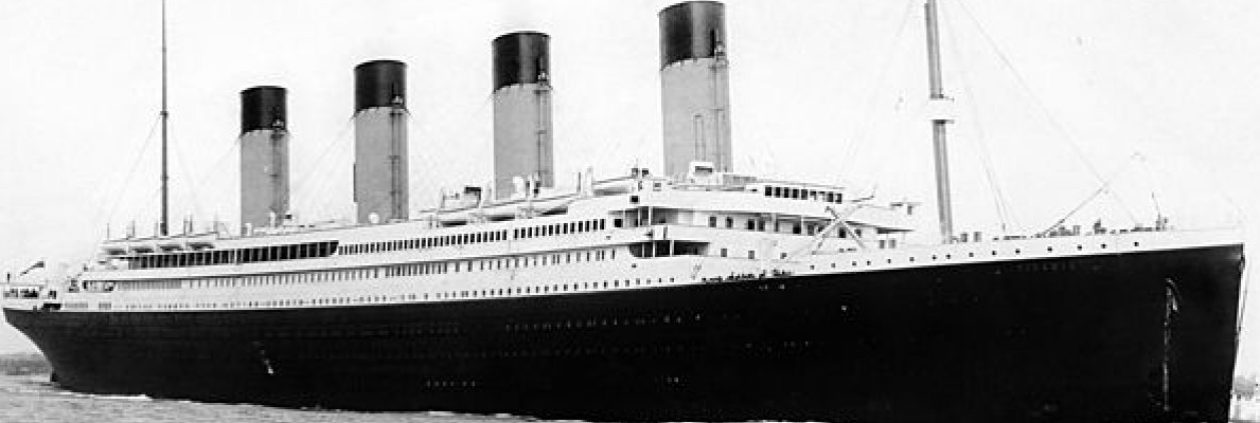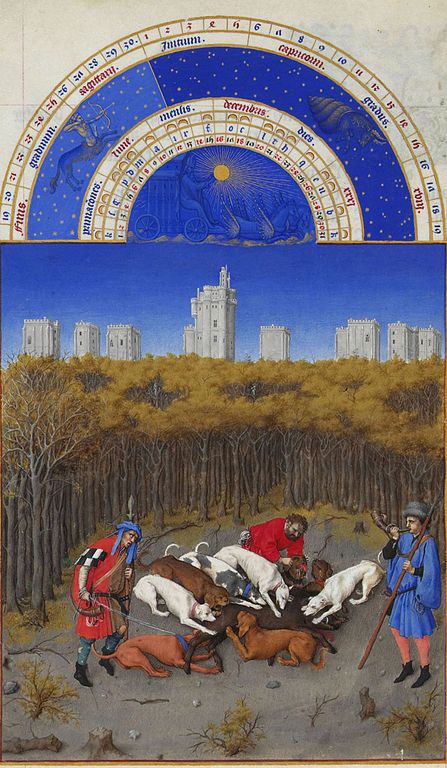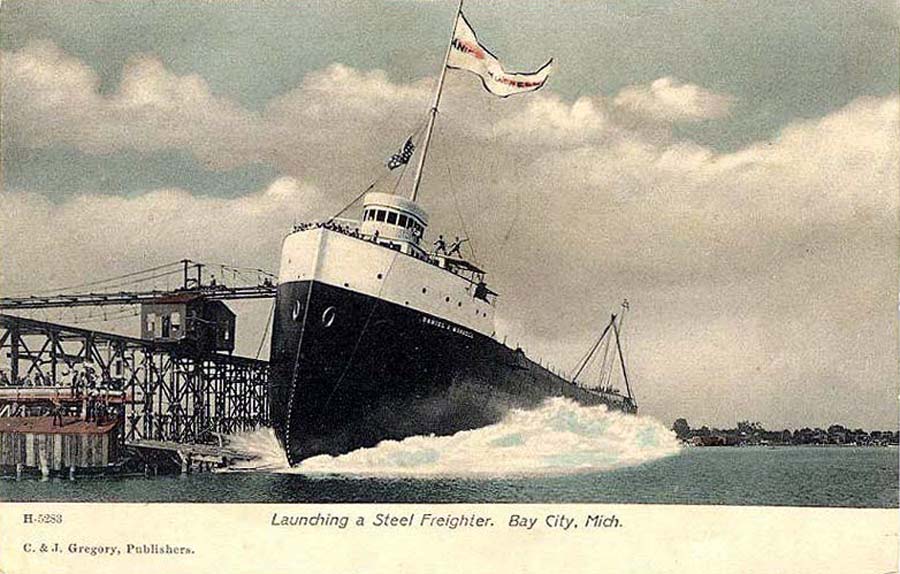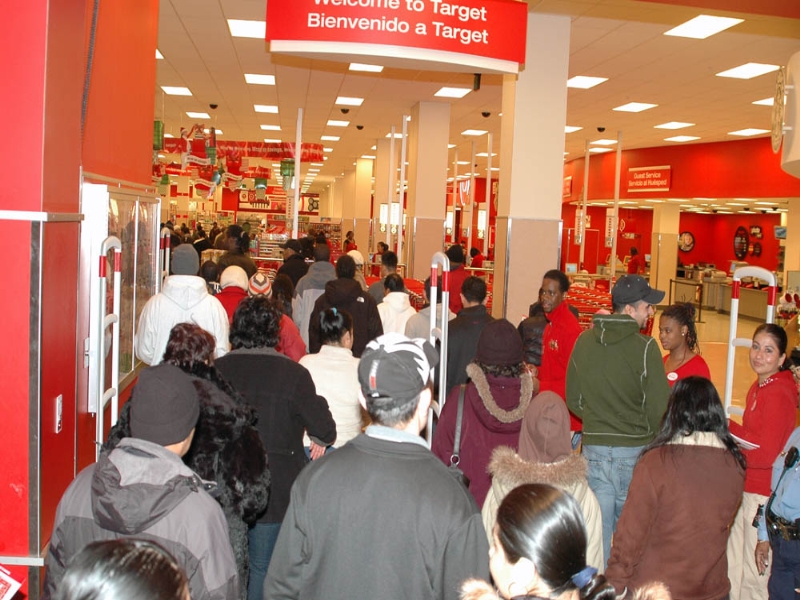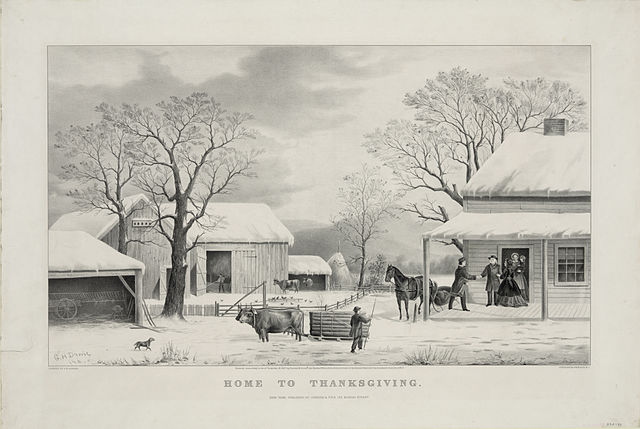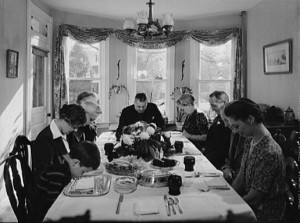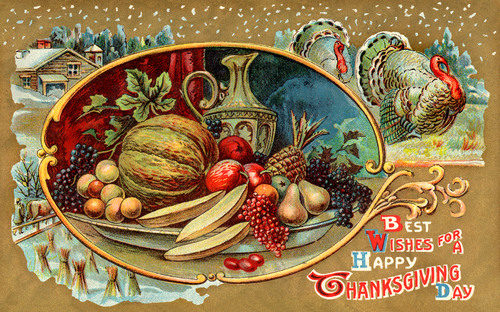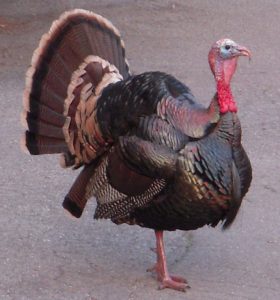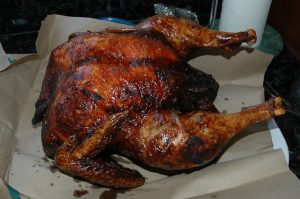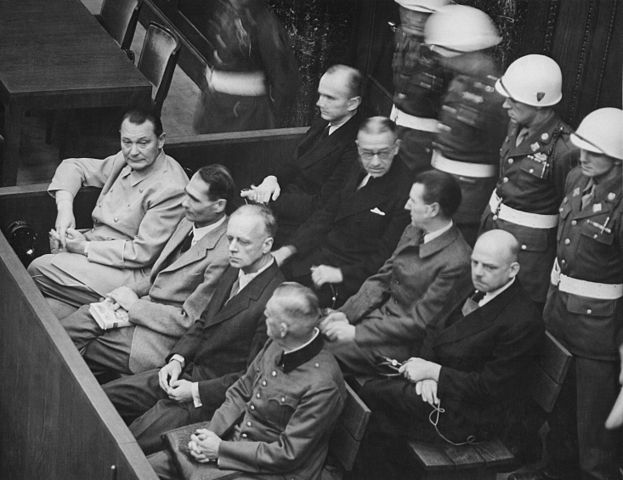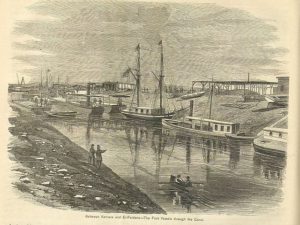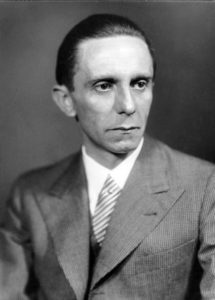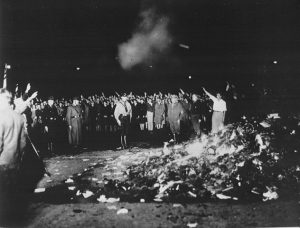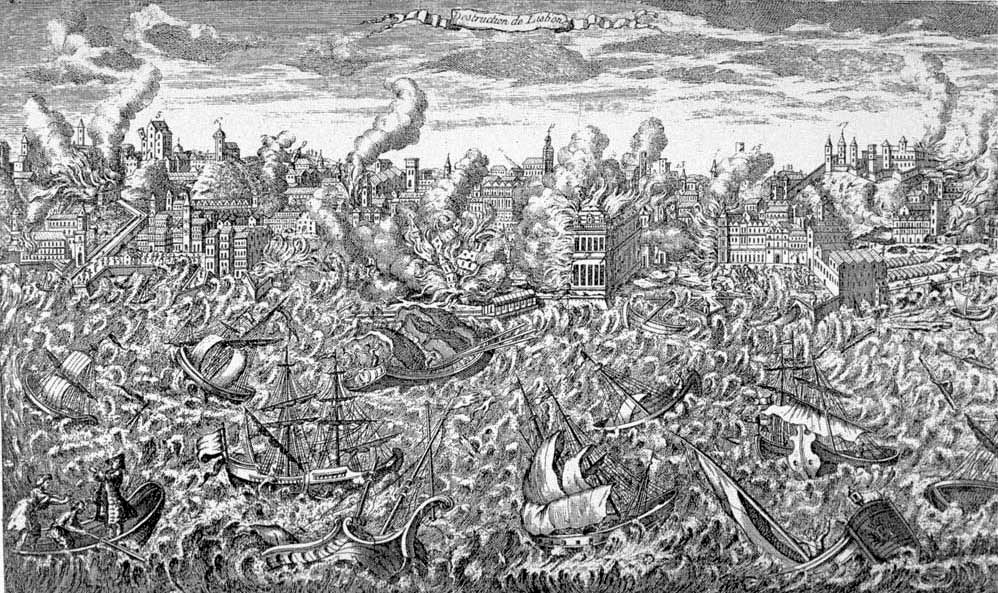[This has been updated for 2024 with grammar, punctuation, and source updating.]
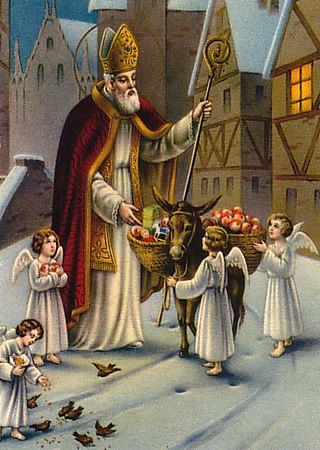
St.Nicholas Center/Pinterest
Today is the feast of St. Nicholas, the basis for what has become known as Santa Claus. He was born in the third century to a wealthy family in the village of Patara (now located on the southern coast of Turkey). At the time the area was mostly Greek. While he was young, his parents died during an epidemic. Raised as a Christian, he believed in obeying Jesus in giving his inheritance to those in need. He dedicated his life to serving God and was made Bishop of Myra was still quite young. He earned a reputation for being generous to those in need, his love for children, and concern for sailors and ships.
During the rule of the Roman Emperor Diocletian, Christians were ruthlessly persecuted, and Nicholas suffered for his faith by being exiled and imprisoned. Despite all of the hardship he endured, he never wavered in his faith. He was released and attended the Council of Nicaea in 325 AD. He died on 6 December 343 AD in Myra and was buried. The anniversary of his death would become a celebration and still celebrated to this day (it is 19 December on the Julian calendar used by Eastern Orthodox churches).
His generous deeds and miracles attributed to him spread during the Middle Ages. Many sailors claimed him as a patron and told of him when they traveled. Churches dedicated to Nicholas appeared in many seaport cities. His name spread both east and west making him a very popular saint with many churches named after him in Austria, Belgium, England, Italy, Russia and Switzerland to name a few. His tomb became popular to visit but concerns over wars in the area cutting off access worried many. In 1087 sailors from Bari were able to retrieve his relics and bring them back. A church was built over his crypt so that pilgrims could visit. The shrine to St. Nicholas in Bari became a major pilgrimage center during medieval Europe. People still visit the shrine today at the Basilica di San Nicola in Bari.
The Roman Catholic Church, Eastern Orthodox, Greek Orthodox, Anglican, and Lutheran churches all have his feast day on their calendars. His generosity and compassion are seen as a model of Christian life. There is some confusion generated about how saint feasts days are celebrated in the Catholic church. Since there quite a number of saints with feasts, it was decided that some saint feast days would be optional for a diocese to celebrate. Saint Nicholas became one of them. He was not stripped of his sainthood. In a diocese where he is popular, has churches or schools named after him, or perhaps the bishop believes he is model to be held up for veneration, his feast day will be celebrated. His feast day is celebrated throughout Europe and in Russia and children receive gifts on the day. Saint Nicholas’ feast day is usually the start of the Christmas season in Europe and elsewhere.
Saint Nicholas and Santa Claus
Saint Nicholas did not fare well during the Protestant Reformation. Saints, even revered ones, were removed to focus on Jesus. Some went so far as to nearly ban any public display of traditional religious customs related to saints or even Christmas (it was not a holiday for that reason in areas that groups like the Puritans dominated). Martin Luther wanted to shift the focus of Christmas to Jesus. The problem was that you cannot have a baby delivering gifts to children as Saint Nicholas did. He came up with the Christkind (Christkindl), a children’s gift giver. This angel, depicted as young girl, brings the gifts when the children are not present. In Nuremberg, the Christkind is selected every two years by vote and between the ages of 16-19. The Christkind opens the Christmas market. She also has her picture taken with kids, listens to what they want, visits kids in hospitals and the elderly as well amongst many other duties. The Christkind was also adopted by many German Catholics as well and spread into Latin America as well. In some cases, both the Christkind and Saint Nicholas deliver presents together.
Despite attempts to diminish Saint Nicholas using the Christkind, he remained popular except in England where many Christmas folk traditions were altered (especially under the rule of the Puritans and Oliver Cromwell). Puritans in America (and some others as well) forbade celebrating Christmas. German immigrants brought celebrating Christmas with them along with Saint Nicholas as well. It was believed the Dutch had brought Saint Nicholas to America, but recent scholarship indicates that was not likely (it is not mentioned in letters or records from the Dutch who lived in New Amsterdam at the time). It appears a series of fictional stories about Saint Nicholas (described as a jolly man with a clay piper) being celebrated by the early Dutch may have been the source.
The 19th century was one of change in America regarding Christmas-and elsewhere as well. Since it was not a sacred or public holiday in many places, it was not the time of carols and goodwill we think about today. Instead, it was a was a rowdy holiday where many got wildly drunk, gambled, and got riotous in some cases threatening people. In England, the Father Christmas figure was about adult merriment and feasting and had nothing to do with children. The actual celebration of Christmas seemed to be fading until books were published depicting Christmas as a time for family, children and faith were published in the 19th century. Washington Irving’s The Sketchbook of Geoffrey Crayon (1819) depicted the celebration of Christmas in England as a warm holiday where peasants were invited into the home to celebrate the holiday. And stories about a magical gift giver called Sante Claus began to appear. Books such as The Children’s Friend (1821) had a character delivering gifts to children on Christmas Eve. Flying a sleigh and living up north, this Sante Claus would form the basis of what is known today as Santa Claus.
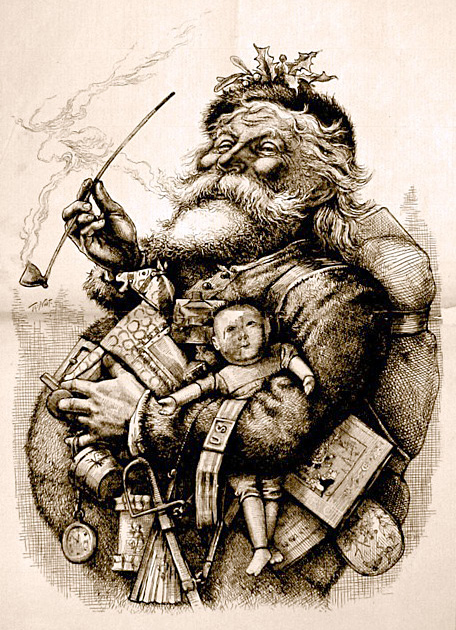
Thomas Nast, 1881
Public Domain
The famous Clement Clark Moore poem A Visit from St. Nicholas would further cement the image of this Sante Claus. Books depicting Christmas began to appear and of course the most famous being A Christmas Carol by Charles Dickens in 1843. This came at a time in Britain when they were re-examining Christmas. This book and others would further help to make Christmas as a time for families, children, and caring about the less fortunate as well. Thomas Nast, the famous political cartoonist, illustrated him as a rotund figure with a beard, fur clothing, and with a clay pipe in 1863. He also changed the name to Santa Claus. His image, with some embellishments and refinements, has remained more or less intact to our time. Christmas was becoming widely celebrated and by 1860 had already been adopted as a state holiday in fourteen states. In 1870, President Grant proclaimed Christmas Day as a federal holiday in the District of Columbia. Congress would pass legislation that made Christmas, New Years, Independence Day, and Thanksgiving as federal holidays (remember back then nearly all federal workers were in the District of Columbia). States would also make it a holiday as well.
By the start of the 1930’s, the American Santa had come full form thanks to various illustrators such as Norman Rockwell. Coca-Cola would use Santa in its advertising further establishing his identity in the commercial world. The jolly man with the red suit would be seen in magazines, billboards, shop counters, and greeting cards. A benign source of happiness and seemingly endorsing all kinds of commercial products, he became as American as apple pie (to coin a phrase). His image would spread out to the world competing with local versions (Father Christmas, Pere Noel, Babbo Natale, Sinter Klass, Julenesse etc.) Saint Nicholas still retains his place in Europe despite this.
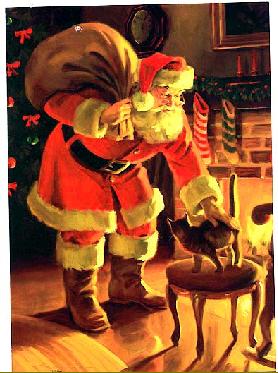
Many people, seeing Santa as a commercial and pagan creation, are now reclaiming the saint for use in the holiday. Saint Nicholas brings a spiritual emphasis to the holiday, which Santa does not. Some have tried to ban Santa Claus because of his supposed connection to Saint Nicholas, except there is none. One is a revered saint and bishop, the other a complete concoction of writers, illustrators, and marketing departments. There is nothing Christian about Santa Claus. Movies like The Santa Clause, while entertaining, put him into a world of fantasy beings like Mother Nature, Cupid, and the Tooth Fairy. By returning focus to Saint Nicholas, we get closer to what the celebration is about-the birth of the savior.
Sources
“Who Is St. Nicholas? – St. Nicholas Center,” St. Nicholas Center, https://www.stnicholascenter.org/who-is-st-nicholas.
“Federal Holidays: Evolution and Current Practices,” Congressional Research Service, last modified July 21, 2021, accessed December 3, 2024, https://sgp.fas.org/crs/misc/R41990.pdf.
“A History of Christmas in America,” The Classical Historian, last modified December 18, 2015, accessed December 3, 2024, https://www.classicalhistorian.com/historyblog/a-history-of-christmas-in-america.
History of Christmas – Origins Traditions & Facts | History, “History of Christmas – Origins, Traditions & Facts | HISTORY,” HISTORY, December 21, 2022, https://www.history.com/topics/christmas/history-of-christmas.
Suggested Media
St Nicholas: Real Story. Vision Video, 2015.
This is an excellent documentary on who Saint Nicholas was and the historical evidence that shows he did exist.
Titanic News Channel is a participant in the Amazon Services LLC Associates Program, an affiliate advertising program designed to provide a means for sites to earn advertising fees by advertising and linking to Amazon.com.
